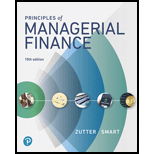
a)
To discuss: Difference between mergers, consolidation, and holding company.
Introduction:
Corporate restricting refers to any activities like expansion or changes in any financial activities or assets or contraction of operation of the firm.
Example: Mergers.
b)
To discuss: Acquiring company and targeted company
Introduction:
Corporate restricting refers to any activities like expansion or changes in any financial activities or assets or contraction of operation of the firm.
c)
To discuss: Friendly merger and hostile merger
Introduction:
Corporate restricting refers to any activities like expansion or changes in any financial activities or assets or contraction of operation of the firm.
d)
To discuss: The strategic mergers and financial mergers.
Introduction:
Corporate restricting refers to any activities like expansion or changes in any financial activities or assets or contraction of operation of the firm.
Want to see the full answer?
Check out a sample textbook solution
Chapter 18 Solutions
Gitman: Principl Manageri Finance_15 (15th Edition) (What's New in Finance)
- Demonstrate the consolidation process when a corporate ownership structure is characterized by mutual ownership.arrow_forwardFour economic classifications of mergers are (1) horizontal, (2) vertical, (3) conglomerate,and (4) congeneric. Explain the significance of these terms in merger analysis with regard to(a) the likelihood of governmental intervention and (b) possibilities for operating synergy.arrow_forwardWhen one company buys the assets and liabilities of another company, this is known as which of the following?Choose one answer.a. Limited liability company b. Merger c. Conventional corporation d. Acquisitionarrow_forward
- Management accounting- mergers and aquisitions Mergers are often categorised as horizontal, vertical or conglomerate. Explain each of these type of mergers in detail.arrow_forwardDemonstrate the consolidation process when a corporate ownership structure is characterized by a connecting affiliation.arrow_forward“Reasons for merger that will result in wealth maximization are strategic benefits, market power, economics of scale, economies of vertical integration and taxation benefits”. Describe how any four out of the five factors mentioned may contribute to the success of a merger business exercisearrow_forward
- A "group" for consolidation purposes is Group of answer choices An entity, including an unincorporated entity such as partnership, that is controlled by another entity. An entity that obtains control over entities or businesses. An entity that has one or more subsidiaries. A parent and all of the subsidiaries.arrow_forwardWhat are the elements of Press Release in Merger & Acquisitionarrow_forwardChapter Merger and Acquisition . Provide all relevant details. • The definition of merger and acquisition • The different types of mergers and acquisitions, why they should (or shouldn’t) take place, and the terminology associated with them. • The benefits from merger or acquisition and how to value the transactionarrow_forward
 EBK CONTEMPORARY FINANCIAL MANAGEMENTFinanceISBN:9781337514835Author:MOYERPublisher:CENGAGE LEARNING - CONSIGNMENT
EBK CONTEMPORARY FINANCIAL MANAGEMENTFinanceISBN:9781337514835Author:MOYERPublisher:CENGAGE LEARNING - CONSIGNMENT Intermediate Financial Management (MindTap Course...FinanceISBN:9781337395083Author:Eugene F. Brigham, Phillip R. DavesPublisher:Cengage Learning
Intermediate Financial Management (MindTap Course...FinanceISBN:9781337395083Author:Eugene F. Brigham, Phillip R. DavesPublisher:Cengage Learning

